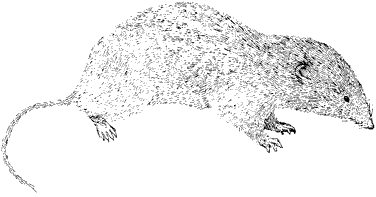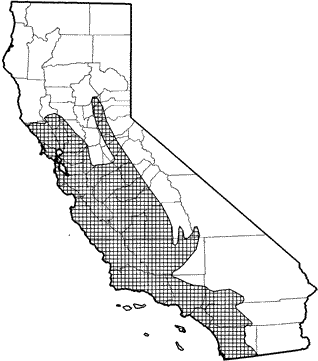
Ornate Shrew
Distribution, Abundance, and Seasonality
The ornate shrew is common in the southern two-thirds of California west of the Sierra Nevada, from Mendocino and Butte cos. south to the Mexican border. Its optimum habitats are valley foothill and montane riparian, but it also occurs in a wide variety of woodland, chaparral, grassland, and emergent wetland habitats. The ornate shrew is generally found below 1875 m (6000 ft). There are two reported specimens from Santa Catalina Island (Owen and Hoffmann 1983).

Range Map
Specific Habitat Requirements
Feeding: Feeds on insects and other invertebrates under logs, rocks, and litter.
Cover: Uses stumps, logs, and litter.
Reproduction: Nests in wood, shrubs, and burrows. One report of nesting in a woodrat nest (Vestal 1938).
Water: No data found, but occurs in dry habitats, so the species may not require water.
Pattern: Prefers moist soil, and is most abundant in riparian habitat, though it is widespread in terms of occupied habitats. Prefers moist microhabitats.
Species Life History
Activity Patterns: Yearlong activity. Most surface activity is nocturnal. Pearson (1959) reported two peaks of activity, one at dusk and another later at night.
Seasonal Movements / Migration: No data found.
Home Range: No data found.
Territory: No data found.
Reproduction: The breeding season may be somewhat later than that of S. vagrans. Most prenancies are in March and April, though they may occur from February through October. The litter size is about 6, and females may have more than one litter in a year. Most individuals do not live to breed a second year. Information above is from Rudd (1955a).
Niche: This small insectivore occurs with other shrews, such as S. vagrans and S. trowbridgii, but its relations with these species are unknown. It is able to occupy drier upland habitats than other shrews. Predators include owls (Von Bloeker 1937).
Comments: Four subspecies of the ornate shrew have restricted distributions and are California Species of Special Concern (Williiams 1986). S. o. sinuosus occurs only in San Pablo and Suisun bays. It is both less abundant and more restricted in distribution than the endangered salt-marsh harvest mouse. It prefers the dense, low-lying cover of salicornia. Marshes and sloughs around the perimeter of Buena Vista Lake (Kern Co.) are the known location for S. o. relictus. This subspecies also may occur in the Tulare basin and at Kern and Pixley National Wildlife refuges, but its status in unknown. The coastal marshes of Los Angeles and Ventura cos., from Pt. Mugu to Anaheim and Newport Beach, constitute the known range of S. o. salicornicus, the status of which is unknown. The Santa Catalina shrew, S. o. willetti, is known from two specimens obtained on Santa Catalina Island, one by Von Bloeke (1967) and one by Williams (1986). It probably occurs in larger, stream-bearing canyons of valley foothill riparian habitat. S. v. sinuosus formerly was considered a full species, S. sinuosus.
Sources & References
California Department of Fish and Game, 1999.
California's Wildlife, Sacramento, CA.
Written by: J. Harris, reviewed by: H. Shellhammer, edited by: S. Granholm
Findley, J. S. 1955. Speciation of the wandering shrew. Univ. Kans. Publ., Mus. Nat. Hist. 9:1-68. Grinnell, J. 1908. The biota of the San Bernardino Mountains. Univ. Calif. Publ. Zool. 5:1-170. Grinnell, J., and H. S. Swarth. 1913. An account of the birds and mammals of the San Jacinto area of southern California. Univ. Calif. Publ. Zool. 10:197-406. Jackson, H. H. T. 1928. A taxonomic review of the American long-tailed shrews (genera Sorex and Microsorex). U.S. Dep. Agric., North Amer. Fauna No. 51. 238pp. Junge, J. A., and R. S. Hoffmann. 1981. An annotated key to the long-tailed shrews (Genus Sorex) of the United States and Canada, with notes on Middle American Sorex. Univ. Kans., Mus. Nat. Hist. Occas. Pap. No. 94. 48pp. Kolb, J. A., and M. White. 1974. Small mammals of the San Bernadino Mountains, California. Southwest. Nat. 19:112-114. Owen, J. G., and R. S. Hoffmann. 1983. Sorex ornatus. Mammal. Species No. 212. 5pp. Pearson, O. P. 1959. A traffic survey of Microtus-Reithrodontomys runways. J. Mammal. 40:169-180. Rudd, R. L. 1955a. Age, sex, and weight comparisons in three species of shrews. J. Mammal. 36:323-339. Rudd, R. L. 1955b. Population variation and hybridization in some Californian shrews. Syst. Zool. 4:21-34. Vestal, E. H. 1938. Biotic relations of the woodrat (Neotoma fuscipes) in the Berkeley Hills. J. Mammal. 19:1-36. Von Bloeker, J. C., Jr. 1937. Mammal remains from detritus of raptorial birds in California. J. Mammal. 18:360-361. Von Bloeker, J. C., Jr. 1967. The land mammals of the southern California Islands. Pages 245-263 in R. N. Philbrick, ed. Proc. Sympos. on the Biology of the California Islands. Santa Barbara Botanic Garden, Santa Barbara. 363pp. Williams, D. F. 1986. Mammalian species of special concern in California. Calif. Dept. Fish and Game, Sacramento. Admin. Rep. 86-1. 112pp.
California Animal Facts | California's Wildlife